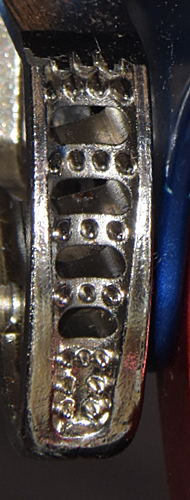I acquired my Kong-Bonaiti double rope new on eBay from Rostislav Burdenyuk in 2009.
The Kong-Bonaiti double rope is 209 mm. tall, 92 mm. wide, 56 mm. thick, and weighs 397 g.
The ascender assemblies
The front ascender assembly is right-handed and the rear ascender
assembly is left-handed. Each shell is a tall irregular shaped
stamping made from 3.4 mm. anodized aluminum alloy sheet
metal that is later anodized. A rope channel is formed in of
one side and a smaller cam channel lies opposite the first. A
hole drilled through both sides of the cam channel accepts a
5 mm. rivet. The cam and cam spring are mounted on this
rivet, along with a flat washer on the inner side of the cam.
A 14.0 by 17.5 mm. oval hole through both sides of the rope
channel provide an attachment point just above the cam. There
is a punched cam stop above the cam, and a 12.3 mm. wide,
10.6 mm.high D-shaped hole above the cam stop.
There is a 12.9 mm.hole punched at the base of each ascender
assembly shell, but it is blocked by the handle. Two
rivets above this hole help hold the two ascender assemblies
and climber handle together. There is another rivet
below the cam channel.
 The cam is a steel casting. The cam has number of
small conical teeth, all of which have their axes approximately
parallel to the upper cam surface. The tooth pattern is (3)(4.H)^2(3.H)^2(3.3.2)
where H is an oval hole. Like the other ascenders, the inner
cam face radius reduces from top to bottom to accommodate various
sized ropes. Each cam is asymmetric, with the back of the cam face angled toward the outside of the ascender. A spring-loaded manual safety bar is mounted on
the bottom of the cam with a small semi-tubular rivet. The normal action
of the spring holds the safety against the cam. When the cam
is opened, the shell interferes with the safety bar, thus preventing
opening the cam. If the safety bar is moved away from the cam
(opposing the spring), it will clear the shell and the cam will
open. At full open the safety can be released and the spring
will hold the safety against the back of the shell. This provides
a means of locking the cam open. An 11.3 mm. tall, 6.9 mm. thumb post is riveted to each cam safetyto assist
in operating the safety mechanism.
The cam is a steel casting. The cam has number of
small conical teeth, all of which have their axes approximately
parallel to the upper cam surface. The tooth pattern is (3)(4.H)^2(3.H)^2(3.3.2)
where H is an oval hole. Like the other ascenders, the inner
cam face radius reduces from top to bottom to accommodate various
sized ropes. Each cam is asymmetric, with the back of the cam face angled toward the outside of the ascender. A spring-loaded manual safety bar is mounted on
the bottom of the cam with a small semi-tubular rivet. The normal action
of the spring holds the safety against the cam. When the cam
is opened, the shell interferes with the safety bar, thus preventing
opening the cam. If the safety bar is moved away from the cam
(opposing the spring), it will clear the shell and the cam will
open. At full open the safety can be released and the spring
will hold the safety against the back of the shell. This provides
a means of locking the cam open. An 11.3 mm. tall, 6.9 mm. thumb post is riveted to each cam safetyto assist
in operating the safety mechanism.
The front ascender assembly is printed with a rigging icon (showing the ascender assembly only) and the word "MODULAR."
Handle
The climber handle attaches between the two ascender assemblies
by the rivets mentioned earlier. The handle is made from
3.5 mm. anodized aluminum alloy. There are no reinforcing
ribs. The handle has a 103 mm. by 49 mm. oval hand
opening. A phosphorescent plastic hand grip is molded to the sheet metal
frame. The handgrip has four shallow, closely spaced finger grooves.
A 13.6 mm. attachment hole is punched near the bottom of the handle.
The front side of the caver handle is printed with the UIAA
logo, "CE," "EN 567, "0426," "AG564," "Made in EEC," "00425 02 0058," and a "PRO" icon. The front side of the handle has "KONG-BONAITI-ITALY" molded into it, and the rear has the molded word "PHOSPHORESCENT."
Cavers and climbers seldom need an ascended for doubled rope, but arborists find them useful in their trade.

